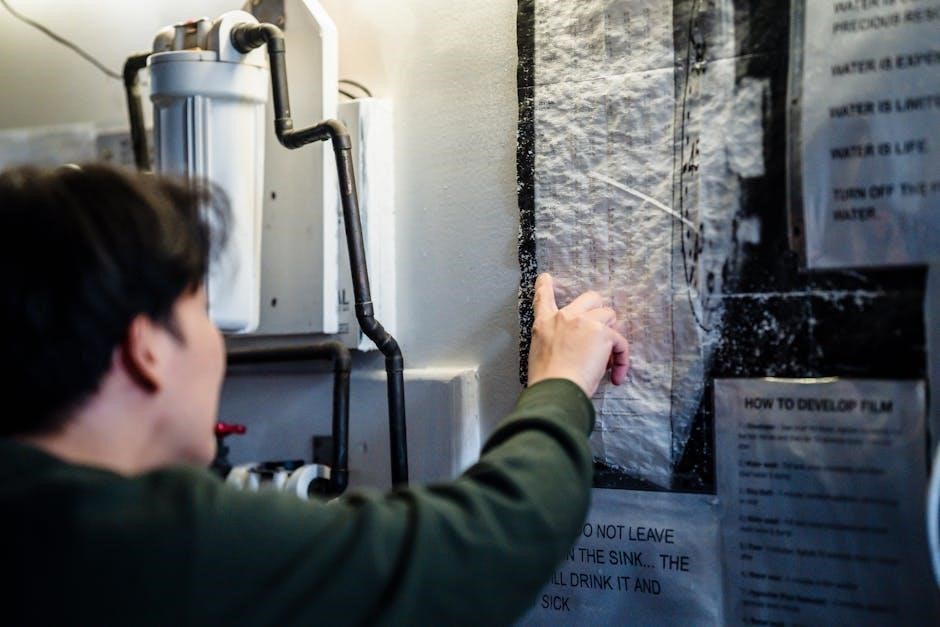The ASVAB Mechanical Comprehension Test evaluates understanding of mechanical principles, tools, and devices․ It is a critical component of the Armed Services Vocational Aptitude Battery, assessing skills for technical military roles and careers․
What is the ASVAB Test?
The ASVAB (Armed Services Vocational Aptitude Battery) is a multiple-choice test designed to assess an individual’s aptitude for various careers in the U․S․ military․ It is used by all branches of the armed forces to determine a candidate’s potential for success in specific roles․ The test covers a wide range of subjects, including mathematics, science, and technical knowledge․ Scores from the ASVAB are used to identify suitable career paths and determine eligibility for specialized training programs․ The Mechanical Comprehension section is one of the key components of the ASVAB, focusing on mechanical and physical principles․ Understanding the ASVAB’s structure and purpose is essential for preparing effectively and making informed decisions about military career opportunities․
Importance of Mechanical Comprehension in the ASVAB
The Mechanical Comprehension section of the ASVAB is crucial for assessing an individual’s ability to understand mechanical principles, tools, and devices․ This section is particularly important for military careers that require technical skills, such as mechanics, engineers, and equipment operators․ A high score in Mechanical Comprehension can open up opportunities for specialized roles and advanced training programs․ It also demonstrates problem-solving abilities and the capacity to work with machinery, which are essential for many military occupations․ Additionally, this section helps the military match candidates with roles that align with their strengths, ensuring effective job placement․ Strong performance in Mechanical Comprehension can significantly impact career advancement and opportunities for enlistment․ Therefore, preparing for this section is vital for those aiming for technical or mechanical roles in the military․

Overview of the Mechanical Comprehension Section
The Mechanical Comprehension section of the ASVAB is designed to evaluate a candidate’s understanding of basic mechanical principles, tools, and devices․ This section includes questions that test knowledge of simple machines, levers, gears, pulleys, and other fundamental mechanical concepts․ Candidates are also assessed on their ability to interpret diagrams and schematics, as well as their understanding of principles like friction, torque, and pressure․ The questions are primarily multiple-choice, requiring applicants to apply their knowledge to solve practical problems․ This section is essential for identifying individuals with the aptitude for technical and mechanical roles in the military․ It focuses on both theoretical knowledge and the ability to apply concepts to real-world scenarios, making it a critical component of the ASVAB for certain career paths․ Strong performance in this section demonstrates a solid foundation in mechanical principles and problem-solving skills․
Understanding the Test Format
The ASVAB Mechanical Comprehension Test is a multiple-choice exam assessing mechanical knowledge․ It includes various question types to evaluate understanding of principles, tools, and devices․ Understanding the format aids in effective preparation and reduces test anxiety․
Number of Questions and Time Limit
The ASVAB Mechanical Comprehension Test consists of 25 questions, and test-takers are given 11 minutes to complete the section․ This time frame is designed to assess not only knowledge but also the ability to think quickly and make accurate decisions under pressure․ With an average of less than 30 seconds per question, effective time management is crucial․ It is important to balance speed with accuracy, as rushing through questions can lead to errors, while spending too much time on a single question may leave insufficient time for others․ Understanding the time constraints helps in developing strategies to allocate time wisely, ensuring that all questions are addressed․ Proper preparation and practice can improve both speed and confidence, enabling test-takers to perform at their best within the given time limit․
Types of Questions in Mechanical Comprehension
The ASVAB Mechanical Comprehension Test features a variety of question types designed to assess understanding of mechanical principles and problem-solving skills․ Most questions are multiple-choice, presenting scenarios or diagrams that require analysis․ Many focus on basic mechanical concepts, such as levers, pulleys, and gears, while others involve more complex topics like fluid dynamics and pressure․ Some questions test knowledge of tools and equipment, asking test-takers to identify their functions or describe their proper use․ Additionally, there are questions that require applying mechanical principles to solve problems, such as calculating forces or determining the operation of a mechanism․ Visual comprehension is also tested, with questions that include diagrams or illustrations of mechanical systems․ Understanding these question types helps in developing targeted study strategies and improving overall performance on the test․
Scoring System and Passing Requirements
The ASVAB Mechanical Comprehension Test uses a percentile-based scoring system, where your score reflects how well you performed compared to a reference group․ Each question is worth one point, and the test consists of 25 questions, so the raw score ranges from 0 to 25․ To pass, you must meet the minimum score required by your chosen military branch, which varies (e․g․, the Army requires a minimum of 23, while the Navy may require higher)․ Higher scores improve eligibility for specialized roles and career opportunities․ Scores are valid for two years and are combined with other ASVAB sections to determine overall qualification․ Focus on achieving a high score to broaden your career options in the military․

Key Topics in Mechanical Comprehension
The test covers essential mechanical concepts, including basic principles of mechanics, tools, simple machines, and fluid dynamics․ Mastering these areas is crucial for success on the ASVAB Mechanical Comprehension Test․
Basic Principles of Mechanics
The basic principles of mechanics form the foundation of the ASVAB Mechanical Comprehension Test․ These include understanding motion, force, energy, and Newton’s laws․ Key concepts involve torque, friction, and simple harmonic motion․ Mastery of these principles is essential for solving problems related to machinery and mechanical systems․
Tools and Equipment
The ASVAB Mechanical Comprehension Test includes questions about common tools and equipment used in mechanical and technical settings․ Understanding the functions, uses, and safety protocols of hand tools, power tools, and fasteners is crucial․ Hand tools, such as wrenches, pliers, and screwdrivers, are essential for basic mechanical tasks․ Power tools, like drills and saws, are used for more complex operations․ Fasteners, including bolts, nuts, and screws, are fundamental to assembling and disassembling machinery․ Additionally, knowledge of measurement tools, such as calipers and micrometers, is important for precision tasks․ Familiarity with hydraulic and pneumatic tools, as well as their applications, may also be tested․ Recognizing and understanding the proper use of these tools is vital for solving practical problems and ensuring safety in mechanical environments․ This section assesses your ability to identify and apply the correct tool for specific tasks, a skill critical for many military and technical careers․
Simple Machines and Mechanisms
The ASVAB Mechanical Comprehension Test covers simple machines and mechanisms, which are fundamental to understanding basic mechanical systems․ Simple machines, such as levers, pulleys, wheels and axles, inclined planes, wedges, and screws, are the building blocks of more complex machinery․ Each machine is designed to make work easier by providing mechanical advantage, changing the direction of forces, or altering the effort required to perform a task․ For example, a lever uses a fulcrum to multiply force, while a pulley system changes the direction of force to lift heavy objects․ Understanding how these machines work, their applications, and their limitations is essential for solving problems on the test․ Additionally, knowledge of mechanisms like gears, cams, and bearings is important, as they are often combined to form compound machines․ Mastery of these concepts is critical for identifying how forces and motion are transferred in mechanical systems, a key skill for military and technical careers․
Fluid Dynamics and Hydraulics
Fluid dynamics and hydraulics are essential topics in the ASVAB Mechanical Comprehension Test, focusing on the behavior of liquids and gases in motion․ Key concepts include pressure, flow rate, and Bernoulli’s Principle, which explains the relationship between pressure and velocity․ Hydraulic systems, commonly used in military equipment, rely on fluids to transmit force, following Pascal’s Law․ Understanding these principles is crucial for solving problems involving pumps, turbines, and fluid-powered machinery․ The test may ask about pressure measurements, flow calculations, and the differences between hydraulic and pneumatic systems․ Mastery of fluid dynamics and hydraulics is vital for careers in mechanics, engineering, and equipment operation, making it a fundamental area of study for ASVAB success․

Strategies for Success

Effective strategies include time management, eliminating wrong answers, and staying calm․ Practice consistently, review mistakes, and use study resources to build confidence and improve problem-solving skills for the test․
Time Management Techniques
Mastering time management is crucial for success on the ASVAB Mechanical Comprehension Test․ Allocate a set amount of time to each question to avoid spending too long on difficult problems․ Practice with timed exercises to build speed and accuracy․ Use the Pomodoro Technique during study sessions: work for 25 minutes, then take a 5-minute break․ Prioritize questions you’re confident about first, marking harder ones to return to later if time permits․ During the test, skip questions you’re unsure of initially to save time for those you can answer correctly․ Finally, review your answers only if time allows, ensuring you don’t waste precious minutes on already completed questions․

Elimination of Wrong Answers
Eliminating wrong answers is a powerful strategy to increase your chances of scoring well on the ASVAB Mechanical Comprehension Test․ Start by carefully reading each question and identifying the key concepts being tested; If you’re unsure of the correct answer, look for obviously incorrect options and eliminate them first․ This technique narrows down your choices and improves your odds of selecting the right answer․ Pay attention to extreme values or units that don’t make sense in the context of the question․ Additionally, be cautious of answer choices that are too similar, as they are often included to trap test-takers․ Trust your knowledge of mechanical principles and avoid second-guessing yourself after eliminating clearly wrong options․ By systematically removing incorrect answers, you can make educated guesses and maximize your score․

Staying Calm and Focused
Staying calm and focused is essential for performing well on the ASVAB Mechanical Comprehension Test․ Anxiety and stress can cloud your thinking, making it harder to solve problems effectively․ To maintain composure, practice deep breathing exercises before and during the test․ Take slow, deep breaths to help clear your mind and reduce tension․ Additionally, remind yourself that it’s okay to skip difficult questions and return to them later—this prevents wasting time and energy on a single problem․ Positive self-talk can also boost confidence․ Instead of doubting your abilities, focus on your preparation and trust your knowledge․ Keeping a steady pace and avoiding rushing will help you stay in control․ By managing your emotions and maintaining focus, you can approach each question with clarity and confidence, ensuring you perform at your best․
Practice and Preparation Resources
Utilize official study guides, online practice tests, and join study groups to enhance mechanical comprehension skills․ These resources provide realistic test simulations and expert tips for effective preparation․
Recommended Study Materials
To excel in the ASVAB Mechanical Comprehension Test, it is essential to use high-quality study materials․ The official ASVAB Study Guide is a must-have, offering authentic practice questions and detailed explanations․ Additionally, textbooks like Mechanical Comprehension for Dummies and Barron’s ME provide in-depth coverage of key topics․ Online resources such as Khan Academy and Magoosh offer interactive lessons and practice tests tailored to mechanical comprehension․ Flashcards and concept summaries from websites like Quizlet can reinforce understanding of basic principles․ Lastly, enroll in prep courses or use mobile apps like ASVAB Prep to access on-the-go study materials․ Combining these resources ensures a well-rounded preparation strategy․
- Official ASVAB Study Guide
- Mechanical Comprehension for Dummies
- Barron’s ME
- Khan Academy
- Magoosh ASVAB Prep
- Quizlet Flashcards
- ASVAB Prep Mobile App
Online Practice Tests and Simulators
Online practice tests and simulators are invaluable tools for preparing for the ASVAB Mechanical Comprehension Test; These resources provide realistic test environments, allowing candidates to familiarize themselves with the format, timing, and question types․ Many websites, such as the official ASVAB practice test portal, offer free or paid simulations that mimic the actual exam․ Platforms like Kaplan, Magoosh, and Test-Guide also provide comprehensive practice tests with detailed explanations․ Additionally, simulators focus on specific mechanical concepts, enabling targeted practice․ These tools help build time management skills, reduce test anxiety, and improve problem-solving efficiency․ Regular use of online practice tests can significantly enhance scores by identifying weak areas and reinforcing understanding of key topics․ They are accessible 24/7, making them a flexible and convenient study option for aspiring test-takers․
- Official ASVAB Practice Test Portal
- Kaplan ASVAB Prep
- Magoosh ASVAB Practice Tests
- Test-Guide
- UnionTestPrep
Joining Study Groups or Forums
Joining study groups or forums is an excellent way to enhance your preparation for the ASVAB Mechanical Comprehension Test․ These communities provide a platform to connect with others who are also preparing for the exam, fostering collaboration and shared learning․ By participating in discussions, you can clarify doubts, gain insights from others’ experiences, and learn new strategies for tackling challenging questions․ Additionally, study groups often share valuable resources, such as study guides, practice problems, and tips for improving test performance․ Online forums like Reddit’s r/ASVAB, Facebook groups dedicated to ASVAB preparation, and specialized military forums are popular options․ These spaces also offer moral support, helping you stay motivated and accountable throughout your study journey․ Engaging with a community can make the preparation process less isolating and more productive, ensuring you feel confident and well-prepared for test day․
- Reddit’s r/ASVAB
- Facebook ASVAB Study Groups
- Specialized Military Forums

Common Mistakes to Avoid
Avoiding common mistakes is crucial for success in the ASVAB Mechanical Comprehension Test․ Misunderstanding question types, rushing through problems, and ignoring basic concepts are frequent errors that can lead to incorrect answers and lower scores․
Misunderstanding Question Types
Misunderstanding question types is a common pitfall in the ASVAB Mechanical Comprehension Test․ Questions may involve identifying components, calculating forces, or understanding mechanisms․ Misinterpreting the question format can lead to incorrect answers․ For example, visual identification questions require naming tools or parts, while performance-based questions demand applying mechanical principles․ Test-takers must recognize whether a question asks for a definition, calculation, or application of knowledge․ Rushing through questions without reading them carefully exacerbates this issue․ To avoid this mistake, practice identifying different question types during study sessions․ Familiarize yourself with the test format and allocate time to thoroughly read each question․ Understanding the question type ensures you apply the correct approach, improving accuracy and confidence․ Regular practice with sample questions helps build this skill, reducing errors on test day․
Rushing Through Problems
Rushing through problems is a frequent mistake that can significantly lower scores on the ASVAB Mechanical Comprehension Test․ Many test-takers, especially those under time pressure, skip reading questions thoroughly or overlook details in diagrams․ This haste often leads to misinterpretation of the question or failure to identify critical information․ For example, a question might ask for the correct tool to complete a task, but rushing may cause a test-taker to select a similar-looking but incorrect option․ To avoid this, practice time management techniques during study sessions․ Allocate a specific amount of time to each question and stick to it․ This helps build the habit of reading carefully and analyzing problems methodically․ Additionally, staying calm and focused reduces the likelihood of rushing․ Remember, accuracy is more important than speed․ By pacing yourself and taking the time to understand each question, you can improve your performance and achieve a higher score․
Ignoring Basic Concepts

Ignoring basic concepts is a common pitfall for many test-takers preparing for the ASVAB Mechanical Comprehension Test․ While it may be tempting to focus on advanced topics, neglecting fundamental principles can lead to poor performance․ Many questions are designed to test understanding of basic mechanical concepts, such as leverage, torque, and simple machines․ If these foundational ideas are not mastered, even seemingly straightforward questions can become challenging․ For example, a question about the operation of a pulley system may confuse someone who hasn’t grasped the basics of mechanical advantage․ To avoid this mistake, it’s essential to thoroughly review basic principles during study sessions․ Start by understanding key concepts like force, motion, and energy, as these form the building blocks of mechanical comprehension․ By ensuring a strong foundation, test-takers can approach more complex problems with confidence and accuracy, ultimately improving their overall score․

Final Tips for Test Day
Ensure adequate rest, review key concepts, and stay confident․ A well-rested mind and positive attitude significantly enhance performance․ Avoid last-minute cramming and trust your preparation to tackle the test effectively․
Getting Adequate Rest
Adequate rest is essential for optimal performance on the ASVAB Mechanical Comprehension Test․ Ensure 7-9 hours of sleep before test day to refresh your mind and body․ Fatigue can impair focus, memory, and problem-solving skills, which are critical for mechanical reasoning․ Avoid late-night study sessions, as they may reduce cognitive efficiency․ Instead, establish a consistent sleep schedule in the days leading up to the test to maintain mental sharpness․ A well-rested brain will process information faster and make clearer decisions, helping you tackle complex questions with confidence․ Prioritize sleep as a key component of your test preparation strategy to ensure you are mentally and physically prepared for the challenge ahead․
Reviewing Key Concepts
Reviewing key concepts is a vital step in preparing for the ASVAB Mechanical Comprehension Test․ Focus on understanding fundamental principles such as simple machines, levers, pulleys, and basic physics․ Regularly revisit study materials to reinforce your knowledge of tools, mechanisms, and fluid dynamics․ Practice applying these concepts to various problems to improve your problem-solving skills․ Use flashcards to memorize important terms and formulas, ensuring you can recall them quickly during the test․ Dedicate time to review areas where you feel less confident, as this will help build your strengths and address weaknesses․ Consistent review will enhance your ability to analyze and solve mechanical problems efficiently, reducing errors and boosting your overall score․ By staying organized and methodical in your review process, you can approach the test with confidence and clarity․
Staying Confident and Positive
Staying confident and positive is essential for performing well on the ASVAB Mechanical Comprehension Test․ Confidence helps you approach questions calmly and make logical decisions․ Build confidence by thoroughly preparing for the test and understanding the key concepts․ Remind yourself of your strengths and past successes to maintain a positive mindset․ On test day, take deep breaths to manage nerves and focus on the task at hand․ Avoid self-doubt by trusting your preparation and abilities․ A positive attitude will help you stay motivated and composed, even when faced with challenging questions․ Visualize success to reinforce your belief in your capabilities․ By staying confident and positive, you can maximize your potential and achieve a strong score on the Mechanical Comprehension section․
